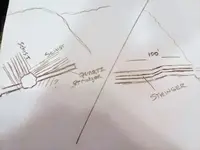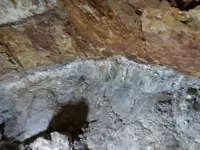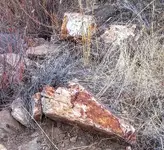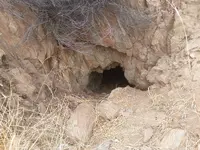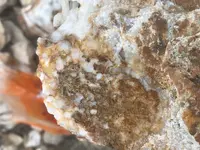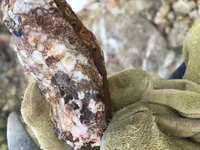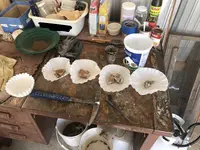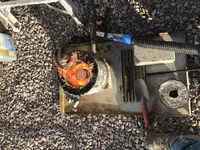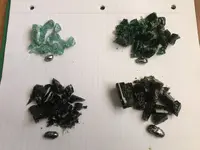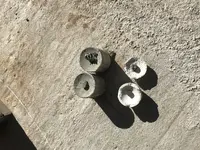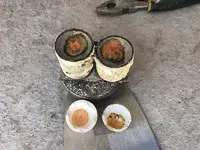I've got a little experience with gold recovery using Mercury. Mercury can be made to work if your particles are a large enough size. Too small and it isn't very effective.
Mercury. Crazy liquid metal. Barely denser than gold. Know for its unique property to "surface tension-up" (amalgamate) gold.
Mercury effectiveness for Gold recovery is all about gold particle size and liberation from foreign (gangue) materials. So how does mercury work? Its all about surface tension. Mercury and native gold because of something to do with the electrons in their outer shells combined with their similar densities, and surface tension, mercury draws gold particles up in to its surface tension and dissolves a very small percentage (less than 0.1 percent of the gold by weight) into the mercury. There's basically no gold particle too large to amalgamate as long as you have enough mercury. However too small of a particle size and you can't get the interface of the respective gold-mercury surfaces. Not enough of the gold can come into contact with the mercury to break the mercury surface tension for it to draw the gold up. For the same surface tension reasons the gold must be totally freed from foreign materials/ coatings (gangue rock, oils, mineral coatings). Around 200 mesh and smaller is where mercury stops being as effective at capturing gold assuming the gold is clean, bright and shiny, which is usually a given for placer gold, not always the case with hard rock ores.
Heres some reference material to contemplate:
https://www.scribd.com/doc/43820757/...covery-Methods (Page 5).
For all its bad rap metallic mercury is pretty safe to living organisms. Vaporous mercury and mercury ions, salts and organic compounds are the big ouch. You could take a swig of metallic mercury (which they used to prescribe for constipation) and it would run through you along with everything else for an interesting bowel movement.
So metallic mercury okay, vaporous mercury, mercury ions, salts and organic compounds whew boy! There've been instances where a couple drops of organic compound mercury killed people. So how do you keep it metallic state? Basically use as little as possible with chemically non reactive materials. Concentrated washed placer sands? Pretty safe. Raw hard-rock ores? Boy you better watch out. All the sulfur and who knows what else in raw hard rock ores can compound with mercury and form who knows what manner of biologically soluble compounds.
Some notes on my experience with fine gold formation/ ore genesis. I did some experimenting with recovering gold from pyritic origin hard rock ores. During the formation event the gold is deposited along with pyritic (sulfide) minerals. Predominantly within iron pyrites in my district, although know to form in calcopyrites and aresno-pyrites (You really don't want to mess with arseno-pyrite). The gold is contained as fine particles and coatings within the crystaline matricies of the vaious pyrite (sulfide) minerals, and is liberated as finely grained sheets, layers, and pockets of finely aggregated gold particles when the pyrites oxidize away. The material I experimented on had gold generally 300 mesh and smaller, a dust more or less. They occur in concentrations enough to be visible when aggregated together but they are not a singular agglomerated consolidated mass of gold but rather aggregated particles of fine gold.
Click image for larger version.
Name: unnamed.jpg
Views: 36
Size: 1.40 MB
ID: 1540520
Gravity separation: Basic gravity separation by panning samples was not effective for me. Probably for two reasons 1) achieving a fine enough particle grind/ liberation size and 2) primitive method used (panning). Probably would help if I ground and classified to a finer size before attempting.
Amalgamation: I achieved a result but low recovery yield when I attempted amalgamation. Process: ground rich samples to about 16 mesh and roasted to neutralize as much reactivity with the mercury as possible. Ran the material in a homemade pan mill. Ran with mercury in the bottom and wetted to the consistency of a thick milkshake with a little jet dry. Grind time 1 hour 3-4 tuna cans of material at a time. Ground to a fine mud and floated out the grind with water. Observed pieces of mosquito eye gold flow out un-amalgamated in the tailings. Recovered mercury and retorted and got a little bead of gold. But I suspect I lost a lot of it, although I do not have assay results on the feed stock and tailings to compare. Click image for larger version.
Name: IMG_9301.JPG
Views: 21
Size: 1.63 MB
ID: 1540531
Some kind of chemical leach may be most effective but I cant make any reccomendations there as I've not sucessfully executed a process I am comfortable with yet.
